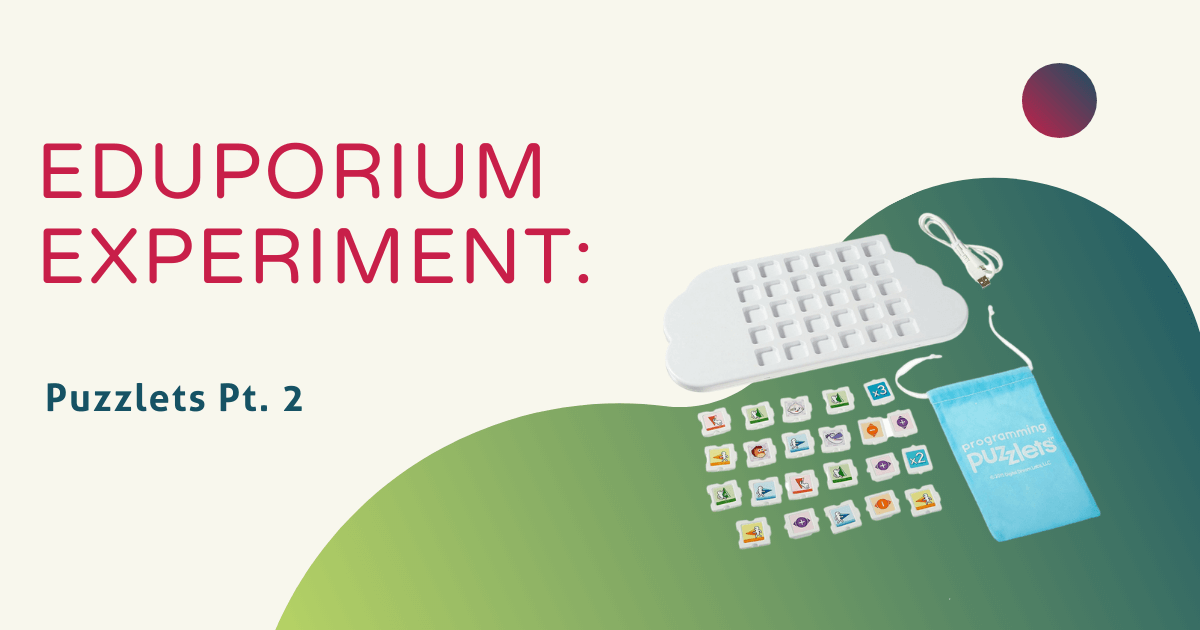If you’re looking to incorporate hands-on play and inspire innovative thinking at an early age, you’re going to love Puzzlets! Puzzlets are a Bluetooth-enabled accessory for tablets or phones that kids can use to play games that teach things like coding, art, and math. It is designed for kids in K-2, aiming to help them explore logic, cause and effect, sequences, and more. It is low-tech, only requiring the play tray, programming pieces, and a compatible device (Android tablets and phones as well as Apple devices). A USB cord is included to charge the tray, and a quick start guide to get kids playing and learning instantly.
Since our last experiment with Puzzlets, they’ve released two new games, Abacus Finch for math and Swatch Out for art. Their original app, Cork the Volcano, was designed to teach coding. Abacus Finch does a bit more, teaching the digits 1-20, addition, subtraction, composition, decomposition, and sequencing. The app includes over 60 levels and is designed to engage children in over 40 hours of productive playtime. Swatch Out teaches color theory, covering primary and secondary colors, tints, shades, and warm and cool colors. This app includes 80 levels and is designed for over 20 hours of playtime. Each of the new apps work with the original Puzzlets play tray but require new Puzzlet programming pieces that have not been released yet.
There are three categories of Puzzlet programming pieces for Cork the Volcano: commands (main moves), modifiers (to enhance commands), and characters (three heroes to choose from). The commands are for moving in certain directions (jump, stop, left, and right), the modifiers are for intensifying, lessening, and multiplying commands, and the characters include Rus, Hippo, and Sydney! Once I became familiar with the various programming pieces, I opened the Cork the Volcano app and easily connected the play tray to my iPad via Bluetooth.
I signed in to the app—which only required my name, and optional fields for age and parent’s email, so guardians or teachers can receive updates on the child’s progress. Then, I started playing! The graphics are very kid-friendly with cute characters and there was cheerful music playing throughout. I learned right away that the play tray reads the pieces left to right and, even if kids skip a space, it’ll read the next piece. I made my way through a couple of levels that taught me how the programming pieces control the character’s actions on the screen. The levels progressed in difficulty, teaching sequencing and how to combine movements.
The challenge of it was a bit lost on me, as I’m reasonably older than the target audience, but I believe Puzzlets’ style and approach to coding would be fantastic for young children who are still new to electronic games and programming. Overall, Cork the Volcano provided a very solid experience that left me optimistic about Puzzlets’ two other games.
This tool aims to combine the physical and digital worlds into a beneficial early learning experience and I would say that it definitely succeeds in doing so! To purchase one for your classroom (or your child), visit the Eduporium store. And, look out next Wednesday for the newest edition of the Eduporium Experiment featuring the meeperBOT! In the meantime, don't forget to follow us on Twitter and Instagram for more and you might as well like us on Facebook, too!



